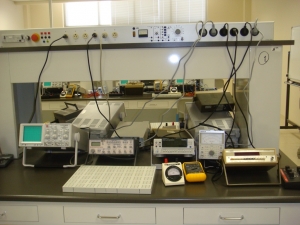
Elementary rules of differentiation

Unless otherwise stated, all functions are functions of real numbers that return real values; although more generally, the formulae below apply wherever they are well defined—including complex numbers.
Differentiation is linear
For any functions f and g and any real numbers a and b the derivative of the function h = af + bg with respect to x is
In Leibniz's notation this is written as:
Special cases include:
- The constant factor rule
- The sum rule
- The subtraction rule
The product rule
For the functions f and g, the derivative of the function h = f g with respect to x is
In Leibniz's notation this is written
The chain rule
The derivative of the function of a function h = f) with respect to x is
In Leibniz's notation this is written as:
However, by relaxing the interpretation of h as a function, this is often simply written
The inverse function rule
If the function f has an inverse function g, meaning that g) = x and f) = y, then
In Leibniz notation, this is written as
Power laws, polynomials, quotients, and reciprocals
The polynomial or elementary power rule
If, for any number then
Special cases include:
- Constant rule: if then f is the constant function f = c, for some number c, and, for all x, f′ = 0.
- if f = x, then f′ = 1. This special case may be generalized to: The derivative of an affine function is constant: if f = ax + b, then f′ = a.
Combining this rule with the linearity of the derivative and the addition rule permits the computation of the derivative of any polynomial.
The reciprocal rule
The derivative of h = 1/f for any function f is:
In Leibniz's notation, this is written
The reciprocal rule can be derived from the chain rule and the power rule.
The quotient rule
If f and g are functions, then:
wherever g is nonzero.
This can be derived from reciprocal rule and the product rule. Conversely the reciprocal rule may be derived from the special case f = 1.
Generalized power rule
The elementary power rule generalizes considerably. The most general power rule is the functional power rule: for any functions f and g,
wherever both sides are well defined.
Special cases:
- If f = xa, f′ = axa − 1 when a is any real number and x is positive.
- The reciprocal rule may be derived as the special case where g = −1.
Derivatives of exponential and logarithmic functions
note that the equation above is true for all c, but the derivative for c < 0 yields a complex number.
the equation above is also true for all c but yields a complex number if c<0.
Logarithmic derivatives
The logarithmic derivative is another way of stating the rule for differentiating the logarithm of a function :
wherever f is positive.
Derivatives of trigonometric functions
It is common to additionally define an inverse tangent function with two arguments,. Its value lies in the range and reflects the quadrant of the point. For the first and fourth quadrant one has. Its partial derivatives are
Derivatives of hyperbolic functions
Derivatives of special functions
Derivatives of integrals
Suppose that it is required to differentiate with respect to x the function
where the functions and are both continuous in both and in some region of the plane, including , and the functions and are both continuous and both have continuous derivatives for. Then for :
This formula is the general form of the Leibniz integral rule and can be derived using the fundamental theorem of calculus.
Conclusion
This is a summary of differentiation rules, that is, rules for computing the derivative of a function in calculus.







